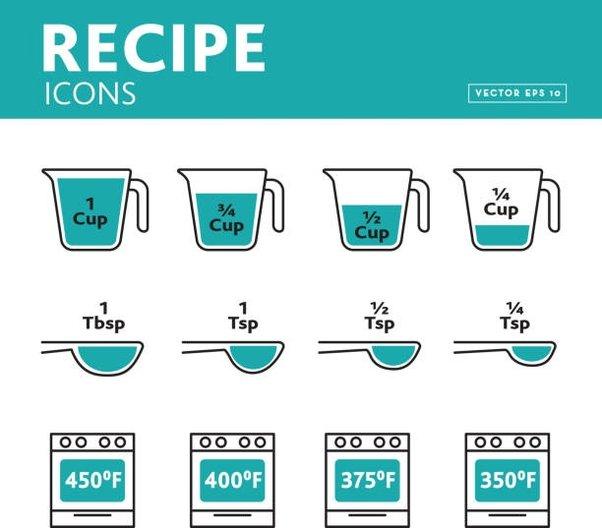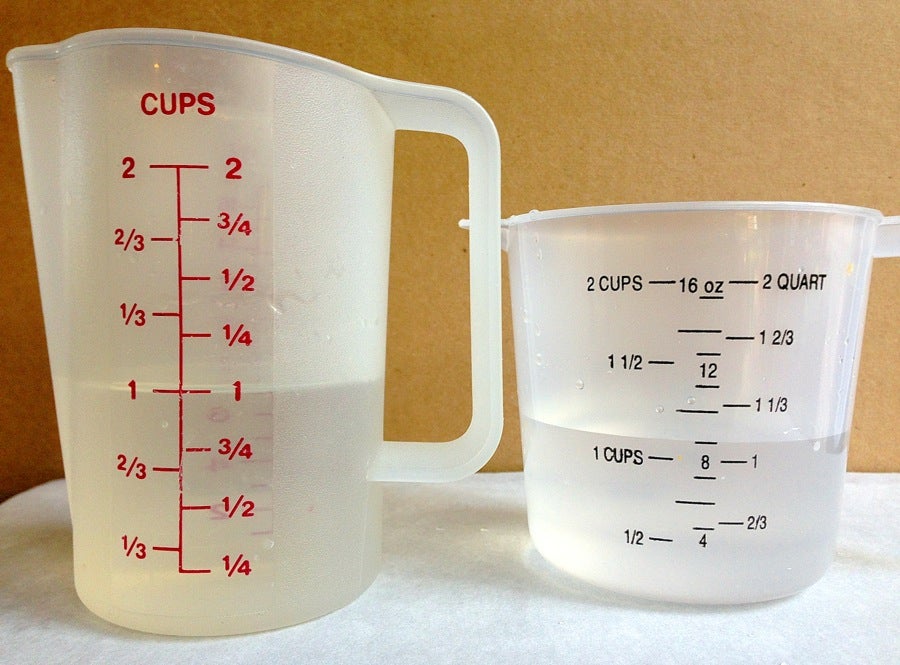Ever found yourself staring at a recipe, measuring cup nowhere in sight, and the dreaded "3/4 cup" staring back at you? Fear not, because achieving this precise measurement is entirely possible, even without a dedicated 3/4 cup measuring tool!
Let's explore the versatile world of kitchen measurement and uncover the secrets to conquering the 3/4 cup challenge. You'll be surprised at the ingenuity you can employ, transforming seemingly impossible tasks into effortless culinary victories. There's more than one way to skin a cat, and certainly more than one way to measure 3/4 cup!
One of the most straightforward methods involves the use of a measuring spoon specifically, the humble tablespoon. Since one cup is equivalent to sixteen tablespoons, a simple calculation reveals the key: You can measure 3/4 cup by using twelve tablespoons. It's a practical and easily accessible approach that sidesteps the need for a specialized measuring tool.
Here's how to execute this technique: Carefully measure out twelve level tablespoons of your ingredient. That's it! This method is wonderfully simple and ensures the accuracy your recipe demands. No more guesswork just precision at your fingertips, all thanks to the often-overlooked tablespoon!
Another reliable path to the coveted 3/4 cup measurement lies in using smaller measuring cups, specifically, a 1/4 cup measure. Three perfectly leveled 1/4 cups combine to equal 3/4 cup! This technique is especially useful when dealing with dry ingredients. Fill the 1/4 cup three times with your chosen ingredient, meticulously leveling it off with a straight edge (like a knife or the back of a spoon) each time. The result? Precise, repeatable, and perfectly measured 3/4 cup!
Of course, you can use your standard measuring cups to accomplish this task. To accomplish this, all you'll need is a 1/2 cup measuring cup and a 1/4 cup measuring cup. First, fill the 1/2 cup to its capacity. Next, measure a 1/4 cup; these two measurements combined equals a 3/4 cup!
Let's also look at some simple conversions for visual clarity. Knowing these conversions can be invaluable when you're in the heat of the kitchen.
- 12 tablespoons = 3/4 cup.
- 36 teaspoons = 3/4 cup
- 6 tablespoons plus 2 teaspoons = 3/4 cup.
If youre dealing with liquid measurements or are caught without measuring cups, you might find that common household containers can be your allies. Household containers that hold 6 fl oz (180 ml) equate to 3/4 cup! This measurement can be found in many common household items like cans, mason jars, or food canisters.
Weighing ingredients also presents a precise solution. If you have a kitchen scale, weighing 6 oz (ounces) of your ingredient will also get you to that 3/4 cup measurement!
Sometimes, even the most basic tools can serve you well. Did you know a fist approximates a cup? Similarly, three eggs approximate 3/4 cup! You can often use markings on the side of the containers, or a quart jar divided can help get you to 3/4 cup.
The ability to measure accurately in the kitchen is fundamental to successful cooking and baking. Precision in measurement allows you to replicate recipes with consistency and to adjust them to your specific tastes and dietary needs. Accurate measurement is vital to achieving desired textures and tastes!
Now that you are equipped with the knowledge, let's examine the versatility of the measurement. While the methods described above are perfect for both dry and liquid ingredients, remember that there are different approaches to measuring each.
For instance, when it comes to dry ingredients, you want to avoid packing them down. Instead, spoon the ingredient into your measuring cup and then level off the excess with a straight edge. With liquid ingredients, however, you'll want to hold the measuring cup at eye level to ensure the liquid reaches the 3/4 cup mark, which is an important practice.
As previously mentioned, using tablespoons is an effective way to achieve 3/4 cup. It is a method that allows for great control and is especially handy for smaller amounts or when dealing with ingredients where precision is paramount. This method is also really useful when measuring spices, extracts, or other concentrated ingredients.
Accurate measuring also ensures success. If a recipe calls for 3/4 cup of something, knowing how to measure this amount will provide the best outcome and flavor profile.
If you are cooking with rice, here is something to keep in mind. A good rule of thumb to figure out how much cooked rice is produced from dry rice is to double the amount. For instance, 1 cup of dry rice will equal approximately 2 cups of cooked rice.
- 1 cup dry rice equals 2 cups of cooked rice.
- 2 cups of uncooked rice equal 4 cups of cooked rice.
- 3 cups of uncooked equal 6 cups of cooked rice.
One of the great things about culinary adventure is that if you make a mistake, you can always adjust the recipe accordingly! One of the most common questions when it comes to adjusting a recipe is how to adjust spices. One thing to consider is you shouldn't double the spices right away! Start with a little bit more and then taste as you go.
When you're doubling a baked recipe, you can simply double any cinnamon or spices, even baking soda or powder. However, for other ingredients, such as vinegar or lemon juice, start by adding a little more than the original amount.
Buttermilk is a common ingredient. Did you know that you can easily make buttermilk? All you need is milk and either white vinegar or lemon juice. Your 3/4 cup buttermilk is now ready to use in your recipe when you mix 3/4 cup milk with 1 1/2 teaspoons white vinegar or lemon juice!
Speaking of household items, if you dont have a measuring cup, you can use other common household items, such as a coffee mug, which is typically about 3/4 cup. Its always a good idea to check your measuring implements for accuracy.
Here's a simple conversion: 3/4 cup is approximately equal to 177 milliliters.
For those wondering: There are 2 half cups in a whole cup.
And for those curious, 1 and 1/3 eighth cups make 3/4 cup.
Let's also consider some other helpful conversions:
- 4 tablespoons (tbs) = 1/4 cup & 12 tablespoons (tbs) = 3/4 cup.
- 12 teaspoons (tps) = 1/4 cup & 36 teaspoons (tps) = 3/4 cup.
So that you can save this recipe for later, here are some conversions:
- Measuring cup = regular coffee mug
- Measuring tablespoon = average dinner spoon
- Measuring teaspoon = standard stirring spoon
For hummingbird food, use a 1/2 cup measuring cup and a 1/4 cup measuring cup. This combination will give you a total of 3/4 cup!
Here's a little cheat sheet for substitutions!
- 1/4 cup buttermilk = 1/4 cup milk + 3/4 teaspoon vinegar;
- 1/3 cup buttermilk = 1/3 cup milk + 1 teaspoon vinegar;
- 1/2 cup buttermilk = 1/2 cup milk + 1 1/2 teaspoons vinegar;
- 3/4 cup buttermilk = 3/4 cup milk + 2 1/4 teaspoons vinegar
Let's delve deeper. To measure 3/4 cup, take a measuring cup and fill it with the desired ingredient. Fill it up to the 3/4 mark on the cup. Its important to ensure that the ingredient is level with the top of the cup to achieve an accurate measurement.
For those that often find themselves cooking or baking, or those who love trying new recipes, understanding precise measurements is essential. A recipe may call for an unusual or specific measurement, like 3/4 cup. To measure 3/4 cup with regular measuring cups, youll want a set with 1/4 cup, 1/3 cup, 1/2 cup and 1 cup. If the set has extra measurements (like 1/8 cup, 2/3 cup or 3/4 cup), consider it a bonus.
Scoop or spoon the ingredient into the cup to measure dry ingredients.
To find out how many 1/3 cups make 3/4 cups, we need to determine how many 1/3 cups fit into 3/4 cups. One way to solve this is by dividing 3/4 by 1/3. When we divide fractions, we flip the second fraction and instead multiply. So, dividing 3/4 by 1/3 is equivalent to multiplying 3/4 by 3/1. In conclusion, when converting 3/4 cups to find out how many there are in 1 cup, the answer is approximately 1 and 1/3 (or 1.33) cups. This knowledge allows you to accurately adjust measurements in recipes and ensures successful culinary endeavors.
Do you want to make tomato paste? How many tomatoes do you need? Or maybe you want to make tomato puree or diced tomatoes? While the answers to those questions are beyond the scope of this article, knowing how to measure 3/4 cup is essential to any successful outcome in the kitchen!
If you have a basic set of measuring cups, you can measure your dry ingredients using 1/4 and 1/2 cups. Combine these measurements to make 3/4 cup. If you dont like using two different measuring cups, fill and dump the 1/4 cup three times.Larger measuring cup sets often include a 3/4 cup, or you can buy 3/4 measuring cups individually. For example, if you have a recipe that requires 3/4 of a cup of sugar, and you measure using a 1/2 cup, you would fill the 1/2 cup once to get 1/2 a cup and then fill it a second time halfway to get that additional 1/4 cup, totaling 1.5 half cups.
Here are a couple of cooking problems to solve!
- Arnold is baking cookies for a bake sale. One batch of cookies requires 2_3/4 cups of sugar. How many cups of sugar will he need to make 3 batches of cookies?
- Hugo is building a deck. He has twelve pieces of wood that are 10_1/2 feet long. He needs to cut them into 3_1/4 foot sections. How many 3_1/4 sections can he get from
Understanding the nuances of measuring can open doors to culinary creativity. By mastering these techniques and substitutions, you can confidently navigate the world of recipes, whether youre a seasoned chef or an aspiring home cook.
And just to reiterate: A good rule of thumb to find out how much cooked rice one cup dry rice is, is to simply double the uncooked amount.Some examples for uncooked to cooked rice equivalences:1 cup dry rice equals 2 cups of cooked rice.2 cups of uncooked rice equal 4 cups of cooked rice.3 cups of uncooked equal 6 cups of cooked rice.
And to recap: Your 3/4 cup buttermilk is now ready to use in your recipe. Mix 3/4 cup milk with 1 1/2 teaspoons white vinegar or lemon juice.
Remember, accurate measurement is not just about following instructions; its about achieving the desired results, creating delicious meals, and enjoying the process of cooking. Armed with these measurement methods, youre well-equipped to conquer any recipe that comes your way. Happy cooking!


